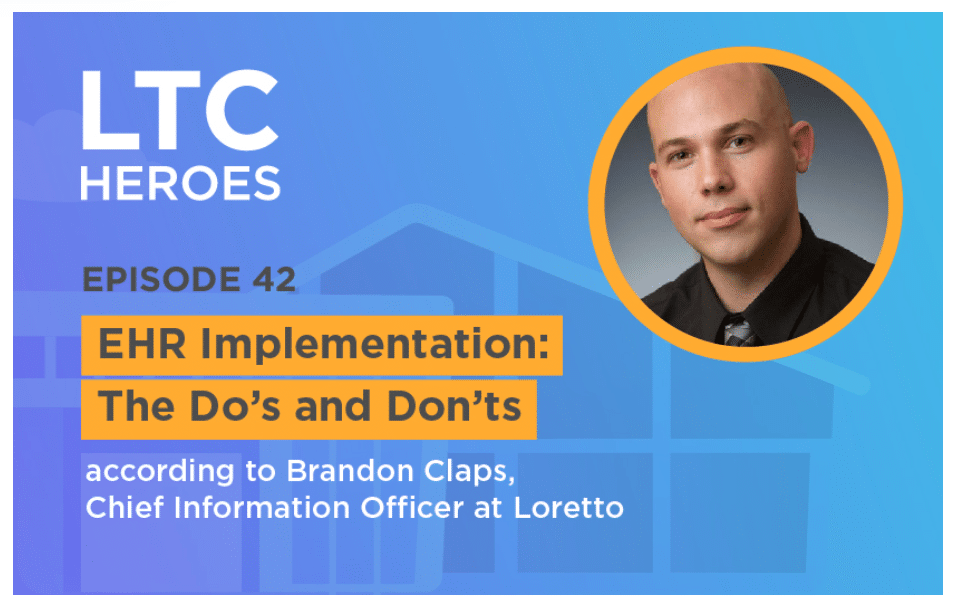
One of the cornerstones of a successful long-term care practice is proper documentation, which is made easier by way of an electronic health records (EHR) system. An EHR is a secure patient record that is available in real-time. EHR systems are more accurate than paper systems, improve efficiency, and reduce costs. The implementation of a long-term care EHR can be a daunting and difficult task. We’re going to take you through everything you need to know to ensure your long-term care implementation is as smooth as possible.
The central importance of EHR systems in modern healthcare is evident in the fact that physicians spend more time entering data than treating patients. However, not all of this time is spent usefully, and there is still a long way to go to improve EHR systems. One study found that 75 percent of staff attribute their burnout to their EHR system, and 85 percent stated that the EHR was harmful to their work-life balance.
Successfully implementing a long-term care EHR, then, is a significant task that requires one to reflect upon the culture and goals of one’s facility. “It comes down to identifying your needs,” said Brandon Claps, a chief information officer at Loretto. He recently finished a successful EHR implementation and shared what he learned during an interview on the LTC Heroes podcast.
Ensure that the long-term care software is reputable and meets your needs
Finding an appropriate long-term care EHR vendor is a difficult task. Claps decided to look for a new care management software vendor after Loretto’s vendor at the time was acquired by another company. That meant Loretto’s facilities were no longer receiving updates nor given a roadmap for future developments. “We were fearful that we were going to find ourselves depending on unsupported software”, stated Claps.
Claps decided to find a more reputable and dependable long-term care software vendor, one which they could rely on over the years. His decision was prudent because, a few years later, the company stated that they were sunsetting the software and would no longer be offering support. Here are Claps tips for finding an appropriate EHR system:
- Understand the needs of your staff: It cannot be overstated how important it is to know what you and your staff want to get out of an EHR. “You have to understand the needs of your business analysts and the IT team, but also those subject matter experts within the organization,” Claps said. “This includes financial, clinical, and operations specialists. You really have to determine when somebody says they need something, what is it that they need.”
- Practice using real scenarios: In addition to discovering the needs of your staff, you will need to create scenarios and use cases that actually matter. Scenarios are concrete and detailed ways that your staff will interact with the EHR system. Claps emphasized that you must see these scenarios in action. “Don’t think that just because it was said that they would be done, and you thought you saw it could be done, that it will actually be done when it comes to implementation,” he said. “There is likely going to be some minor changes or difficulties or quirks that you were not aware of.”
- Find a reputable long-term care software vendor: The last thing that you want to happen is to spend a lot of money and time implementing an EHR and then discover that the company will not be supporting the software in the future. All the work in implementing the software would go to waste.
- Scrutinize the contract: Do not be hesitant to request what you think is reasonable. Claps stated that he and his team “went through [their EHR contract] line by line, and made a lot of adjustments and red lines. Our vendor ultimately agreed to all of them.” They were particularly attentive to issues regarding data and payment terms. “Scrutinize the contracts,” exclaimed Claps, “Out clauses, payment terms, late fees, and interest are all important details.”
Consider Hiring an EHR Implementation Specialist
Expert advice is crucial to your EHR implementation. The Office of the National Health Coordinator for Health Information Technology offers a guidebook for how to successfully implement an EHR system. But that will not be enough to ensure a smooth and successful transition.
Hiring an EHR implementation specialist is usually the right move for facilities. Claps shared how the EHR vendor proposed this idea to him initially. Given that Loretto was initially using a paper-based system, the vendor knew that they would require more training to make full use of the EHR system. Claps listened and has no regrets.
How Specialists Help Implement a Long-Term Care EHR
Training: EHR training starts with the very basics. Claps stated that he had staff that had never even touched a computer before they were to be trained on the long-term care software. Naturally, many were hesitant about moving to an electronic system.
While vendors vouched that their systems were easy to use, Claps knew that the staff would still need to be properly trained in order to make effective use of the EHR system. “We felt that it was important to make sure that we have the expertise across all disciplines in order to maximize our investment in the new EMR,” he said. In fact, Claps invested so heavily in training that, in just three weeks, they were able to train over 800 employees remotely during the pandemic.
Managing new processes and workflows: Training consists of more than just computer literacy. The implementation of a new EHR system also means a change in processes and workflows. Claps found that there were a lot of processes and workflows that needed to be adjusted, and they relied on the EHR implementation specialists to guide them through the training process. This included experts from another EHR vendor with tremendous experience. “Given that our organization was paper-based, we wanted to bring in some external expertise to help understand our current processes and configure the EHR system to adapt to our current processes as much as possible,” he said. These experts also walked the staff at Loretto through the changes and expectations that result from using the software.
Make Sure You Have Sufficient Funds for EHR Implementation
Planning for an EHR implementation means planning for the cost as well. Claps, thus, emphasized the importance of developing an accurate budget as part of the EHR implementation process. There are a few things to consider when developing an accurate budget:
- Vendors do not display prices on their websites: Because vendors are not transparent about pricing, it will require an initial round of inquiry to understand the costs involved. You can expect it to take a bit of time to arrive at a ballpark figure.
- Not all modules are priced equally: Modules vary in price greatly. Some may involve cutting-edge technology or be difficult to implement. It is therefore important to understand the needs of your facility to then understand which modules are necessary for a successful implementation.
- EHR training is expensive: You must also account for the cost of training your staff on the software. This includes taking nurses with great responsibilities off the floor to help others pick it up. The cost of training is heavily dependent on the size of your staff as well as their experience with EHRs and their computer literacy in general. Fortunately, there is now an alternative: Experience Care recently launched free online training courses for EHR. LevelUp is available to the general public and can be viewed at any time and in any setting.
Integrating Your LTC Charting Systems
A nursing home needs more than just an EHR. There are multiple applications; electronic Signatures, physicians orders, eMAR, Point of Care —that must be able to speak with your EHR for you to successfully document all aspects of care. Claps stated that one must seek full integration in the implementation process. This is so as to ensure that it works efficiently.
Staff members already spend more than half their time with LTC charting systems. So you will want to minimize the amount of time they are behind a computer or on a tablet in order to get them back on the floor helping people. That is why integration is so significant. Unless a system is fully integrated, it will require your staff to enter data more than one time. “To be fully integrated with all the other systems that a long-term care organization needs means eliminating duplicative work,” Claps said. “A single system can feed all the other ancillary systems, whether it be nurse call systems or work order systems for repair.”
Gauge the Success of Your Long-Term Care EHR Implementation Using Scorecards
It is always wise to keep track of your progress and areas that need improvement. For this reason, Claps biggest point of emphasis in implementing an EHR was to develop scorecards and dashboards. As the authors of The Balanced Scorecard originally wrote: “what you measure is what you get.” A balanced scorecard is a snapshot that gives managers a comprehensive view of the business. In the case of software, that is a comprehensive assessment of its implementation. For Claps, this scorecard included software and IT issues as well as the type of care that they were delivering to patients and residents. Some questions that they asked in their scorecard were:
- How many modules of that EHR have been implemented?
- Include smaller tangible targets for each module. For example, are you missing initial weights and baseline vitals? How many pending orders do you have? How many issues do you have from a skin and wounds standpoint?
- What is your percentage of point of care documentation?
- What is our percentage of your EMR documentation?
Summary
An EHR system is simultaneously a requirement, a blessing, and a curse. It helps facilities stay in compliance with federal regulations, it makes documentation more efficient, but it can also initially be a major source of frustration. It is for this reason that it is crucial to make sure that you have properly understood the needs of your facility, secured a viable contract from a reputable long-term care software vendor, and successfully trained your staff to make full use of the EHR system. As Claps’ experience makes evident, implementing a long-term care EHR system is no easy undertaking, and it might be worth contacting third-party vendors to help with the implementation.
For more on recent trends in long-term care, read our blog and subscribe to the LTC Heroes podcast. Contact us here if you would like to test drive our user-friendly software.
Listen to the Podcast.
